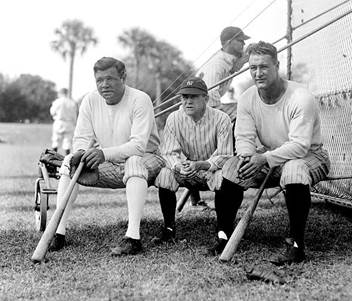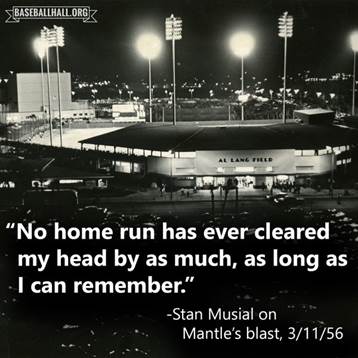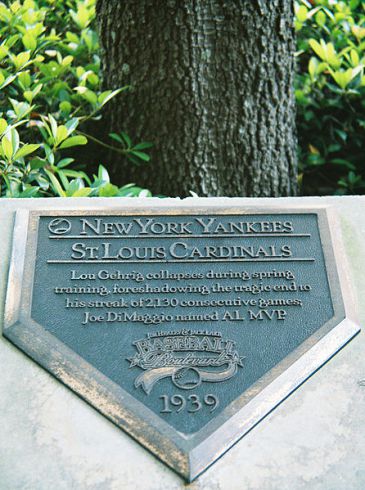In Hot Stove #8, I lauded Bill James for his Nostradamus moment from 15 years ago when he predicted how Donald Trump might become President.
I sent my post to sportswriter Joe Posnanski who often writes about James’ insightful work in sports statistics. I lamented to Joe that the Trump prediction had not received wide coverage in this crazy election year.
Well, Joe has remedied that splendidly and also gave a nice nod to yours truly (click here).
I thought this was pretty cool and, in a shameless seeking of kudos, sent off the link to some folks who share my view that Joe is one of our top sportswriters.
Richard Martin’s perfect response brought me back to earth: “Wow! Your 15 minutes have started.”
The 15 minutes are long over, but they were fun.
Now for some spring training history as Rita and I pack (well, Rita does all the packing) for our trip next week to see the Royals in Arizona:
Spring Training – Circa 1950: When I was a kid, spring training meant “St. Petersburg” – that is the dateline I saw in the articles in the Kansas City Times (RIP) and the Kansas City Star. Al Lang Stadium in St. Pete was the spring home of the New York Yankees, parent team to our Kansas City Blues. Before the A’s moved to KC in 1955, the Yankees were my major league team, and the start of spring training meant reading about the likes of Phil Rizzuto, Mickey Mantle, Whitey Ford, Yogi Berra and Billy Martin. Not only did the Yankees play in St. Pete, but so did our Missouri neighbor, the St. Louis Cardinals. In those days, that meant Stan Musial, Red Schoendienst, etc. Both teams won several pennants over the years, and that success drew many fans to St. Petersburg.
Last year, Rita and I were in St. Petersburg to visit my cousin Tom and his wife Marcy. We made the pilgrimage over to see Al Lang Stadium, only to find that it is now a soccer-only venue. More on that at the end of this post.
St. Petersburg and Al Lang: In 1910, Al Lang was 39, living in Pittsburg and suffering from respiratory ailments that threatened his life. He sold his business, moved to the clean air of St. Petersburg, got healthy and became a cheerleader for growth in his new city. One of his ideas for increasing tourism was to lure a major league team to the city for spring training. In 1914, GM Branch Rickey of the St. Louis Browns took the bait – and also the incentive package of travel and other expenses paid by the city. This was a quiet precursor of the multi-million dollar incentive packages that sports teams demand today.

Spring Training – St. Petersburg – 1914
Lang continued to recruit teams during his two terms as mayor from 1916 to 1920 and for the rest of his life (died in 1960 at age 89). Nine different teams played there from 1914 to 2008. When a new stadium was built in 1947, it was aptly named Al Lang Stadium. In the first game at the field, the dignitaries included Commissioner Happy Chandler, A’s owner Connie Mack, sportswriter Grantland Rice and Hall of Fame shortstop Honus Wagner who Lang had known since his days in Pittsburg. Stan Musial homered in that inaugural game and the Cards beat the Yankees. In this vintage video, there are clips of the stadium opening ceremony and action from games during the 1947 spring training season, including a Ted Williams homer (click here, 9.5 minutes).
The Cardinals were in St. Pete from 1938 to 1997 except for three war years. The Yankees were in the city from 1925 to 1961 except for three war years and in 1951 when owner Del Webb wanted to be closer to his real estate developments in Phoenix. The New York Giants swapped with the Yankees that year and the two teams then met in the 1951 World Series, the first for rookies Mickey Mantle and Willie Mays (Yanks won 4-2).
St. Petersburg and Babe Ruth: Babe Ruth was always larger than life in any venue, and spring training was no exception. My primary source on Ruth’s time in St. Petersburg is Under the March Sun, Charles Fountain’s book on the history of spring training. He writes that the Yanks had been training in New Orleans, and owner Jake Ruppert felt that the brothels and speakeasies were too much of a distraction to his players, particularly Ruth. St. Petersburg might have its own temptations – “Ruth could find an opportunity for sin in a church” – but the image would be better. Wherever Ruth went, the press followed and this made St. Pete the center of spring training. Clubs previously had paid the expenses of sportswriters covering spring training to assure there was coverage in advance of the regular season, but Ruth sold papers and the reporters no longer needed club incentives. Stories of alligators in the outfield, tape-measure home runs, contract negotiations and golf and fishing excursions were added to the box scores in the dispatches going back to New York. What was not mentioned was the Babe’s hotel suite where the bathtub was filled every night with the best of Prohibition liquor.

Babe Ruth, Miller Huggins and Lou Gehrig – 1929
Ruth was the first big name of a long parade of stars through St. Petersburg. For the Yankees, that included Gehrig, DiMaggio and Mantle; and for the Cards, the Gashouse Gang, Musial and Bob Gibson.
The Grapefruit League: Lang and others continued to recruit teams, and by the late 1930’s, 8 of the 16 teams were settled in Florida in what had become the “Grapefruit League.” Seven of the other teams moved from year-to-year, often based on the best incentives they could get from the cities. The Cubs played on Catalina Island (the Wrigley family owned both the team and the island). Spring training in Florida was halted from 1943 to 1945 as Commissioner Landis established the “Potomac Line” to satisfy war transportation restrictions. No team could hold spring training south of the Potomac or west of the Mississippi. The restriction was lifted in 1946, and many teams returned to Florida. The Dodgers trained in Daytona Beach and welcomed Jackie Robinson to their camp. Florida and Jim Crow did not put out the welcome mat for Jackie.
Spring Training and Jim Crow: Jackie Robinson did not have an easy time in many major league cities when he broke the color line. But nothing compared to the indignities of spring training. Florida was still clinging to its slave state legacy, and Jim Crow was in full bloom. Jackie could not eat in restaurants or stay in hotels with his team. The stands were almost always segregated. One of the sorriest stories is that Jackie’s wife Rachel was not even allowed to enter one stadium through the normal entrance. She was instead directed to the “colored” entrance which was a board removed from a fence near the black seating section. In almost every biography by a black player from that era (Roberto Clemente, Curt Flood, Jackie and Frank Robinson, Bob Gibson, Bill White, etc.), there are invariably horror stories about the treatment of non-white players at spring training.
The Dodgers mitigated the problem in 1947 and 1948 by training in Cuba and the Dominican Republic. In 1949, Dodger GM Branch Rickey established a new spring training camp at an abandoned naval air station in Vero Beach. All of his major and minor leaguers could reside in the old barracks – free of Florida’s Jim Crow law, a very important factor for the team that would recruit more black players than any other and would win six pennants in ten years. “Dodgertown” would be vastly improved over the years by owner Walter O’Malley and was the spring training home of the team from 1949 to 2008. But that was the only oasis for black players in Florida. Many teams were reluctant to rock the boat. One example was GM Frank Lane of the KC A’s who said “we have to subscribe to what has been done in the past” and the A’s had no plans to force the issue of integration in West Palm Beach.
Crusading black newspapers and the NAACP applied pressure. Wendell Smith of the Pittsburgh Courier traveled and roomed with Jackie Robinson in 1947. His dispatches dramatically boosted the paper’s circulation to a black community eager to hear about Robinson and his Rookie of the Year season. Smith personally broke another color line when he moved in 1948 to Chicago’s American to become the first black sportswriter on a major metro newspaper. He fought for the cause over many years, and his front page story of January 23, 1961, was broadly publicized:

Black players were often reluctant to complain because they did not want to risk their new status as major leaguers. But as more black players joined the teams, their discontent became more public. When the Milwaukee Braves told reporters that black players were satisfied with their housing, Hank Aaron publically disagreed. Curt Flood, Bob Gibson and Bill White of the Cardinals were instrumental in applying pressure in St. Petersburg, and blacks in St. Louis threatened to boycott the products of the owner Anheuser-Busch. In turn, the Cards threatened to leave St. Petersburg if the city could not find a suitable hotel. Money trumped Jim Crow and all Cardinals were able to live in one place in 1962. Stan Musial and Ken Boyer even gave up their own private accommodations to move in with the team and help break the local custom.
By 1964, the Grapefruit League was free of segregation, no doubt nudged by the coming Civil Rights Act of 1964 which prohibited discrimination in public accommodations. In 1993, Wendell Smith was posthumously awarded a place in the writers room at the Baseball Hall of Fame, voted in by the Baseball Writers Association of America, a group that had blackballed him from membership for many years.
St. Petersburg – Today: In 1998, the expansion Tampa Bay Devil Rays (now just the “Rays”) made their major league debut at the domed stadium at Tropicana Field in St. Petersburg. The city also was the spring training home for the Devil Rays until 2008 when spring training in St. Pete ended after almost 100 years. Al Lang stadium is now a full-time soccer field for the Tampa Bay Rowdies.
The spring training history of St. Pete was memorialized in 1998 by a path of 85 brass home plate plaques installed along “Baseball Boulevard” from Al Lang Stadium to Tropicana Field. When upkeep for the plaques became difficult, most of the plaques were relocated to the bottom edge of the façade above the admission gate at Al Lang. When Rita and I visited last year, we could only find the 1914 plaque which was on a wall. With the help of some workers at the site, we found out that the plaques were still on the façade, but had been covered by a big sign for the Rowdies. We understand that baseball history might not be appropriate for a soccer-only facility, but hopefully the city will move the plaques to a place where residents and tourists can relive the history. Each plaque includes the name of the one or two teams that played each year and some notable facts that happened to the teams that season. For example, the 1956 plaque says that Don Larsen started the year with a spring training auto accident and finished with a perfect World Series Game; Mickey Mantle won the Triple Crown and American League MVP. This would have been no surprise to Stan Musial who had this to say about Mantle during spring training that year:

The most poignant plaque is for 1939 when Lou Gehrig collapsed during spring training. He played about a month into the 1939 season and then took himself out of the lineup to end his 2,130-game streak. The plaque is shown below as originally installed along Baseball Boulevard:

Short Takes:
Johnny Gomes was the head cheerleader for the Royals celebration at Union Station last fall. He is in spring training in Japan and has already hit a couple of homers (click here for video with Japanese sportscaster).
And since we started with Trump, may as well finish that way. Pete Rose, so far unelectable to the Hall of Fame, commented on the presidential election with an autographed baseball that gave the appearance of endorsing Donald Trump. Pete’s lawyer says not so (click here).
Coming Hot Stove Attractions: The Royals in the Cactus League and on Opening Day 2016.